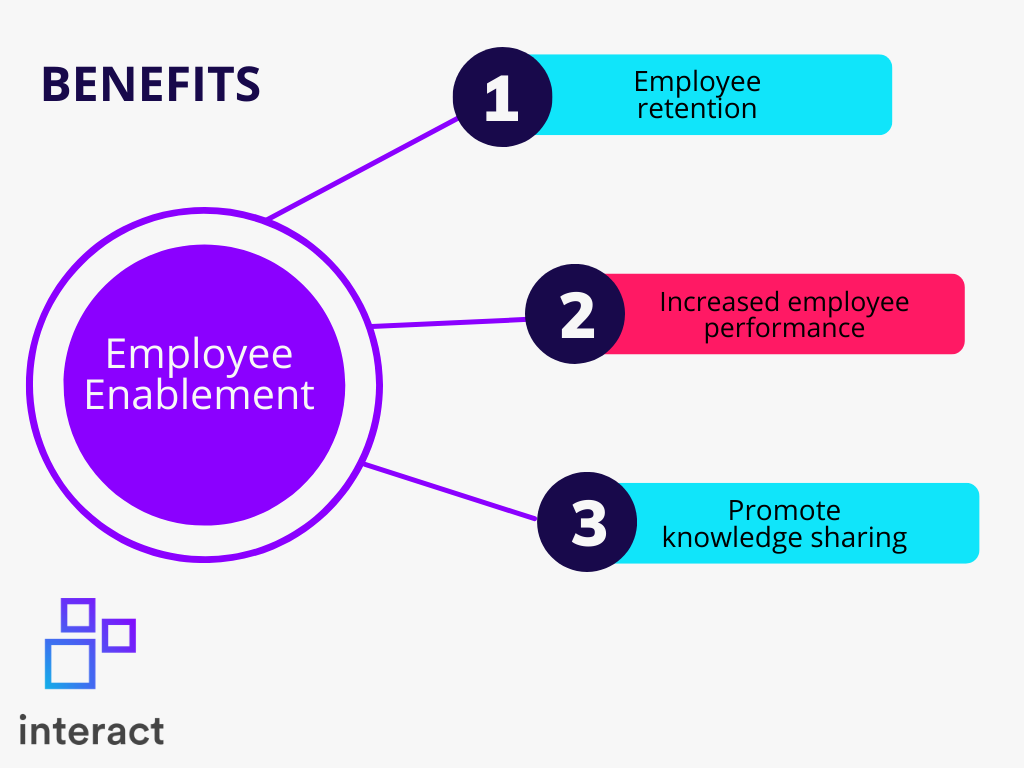Employee engagement is a valued priority for managers and successful businesses. But focusing solely on engagement isn’t always enough to transform company culture and create a thriving work environment. Even for organizations that have improved employee engagement, it may be time to take the next step and focus on employee enablement too.
What is employee enablement?
Employee engagement is pretty mainstream these days. There are clear advantages to having a highly motivated workforce, which probably explains why adoption is so widespread. From start-ups to giant global enterprises, everyone seems to understand that engaging with your employees is a two-way street that benefits all. And, whether it’s causative or correlative, organizations with higher levels of engagement typically perform better and have reduced levels of staff absenteeism and turnover.
Employee enablement seeks to produce similarly positive business outcomes, but it does so by focusing on different areas of employee growth and workplace culture.
As the name suggests, employee enablement is the process of giving employees what they need to do their jobs – in short, enabling them through training, resources, beneficial initiatives, autonomy, flexibility, and much more.
Enablement goes far beyond simply providing new hardware, and it may also include implementing software or refining working processes to help individuals break away from minor distractions and annoyances, thus maximizing productivity and allowing staff to complete tasks quickly, efficiently, and to their own satisfaction.
In the sense that employee enablement should be ongoing throughout a business’ lifecycle – rather than spiking at specific points as with engagement (e.g., around a comms campaign for the launch of new initiative) – it is arguably closer to the lifecycle focus of employee experience.

Considering how you might improve your employee enablement environment means examining your systems, processes, and resources from the position of your workforce. For example, is there an easily searchable internal knowledge base holding important information on procedures on policies? Does your digital workplace have key software integrations that make booking vacation or checking a payslip a quick task rather than an arduous process that takes multiple emails?
One thing is for sure; enabling your employees in this way will positively impact your organization’s bottom line.
Keep internal comms fresh with 101 Employee Engagement Ideas
What are the benefits of employee enablement?
While engagement is a good measure of motivation and employee satisfaction, enablement is a key way to drive both of those metrics higher by putting more power in your employees’ hands.
If individuals need specific development or knowledge to ensure that they continue to grow, they should be confident in receiving this support. In turn, this leads them to being more motivated and engaged, which produces benefits for the company in the form of better customer service, higher productivity, and a flourishing culture.

For those adopting an overall strategy of employee enablement, the benefits are numerous.
1 Improved employee retention
Companies that empower their people are likely to keep them and see their best work. If the workforce is happy and developing, with opportunities ahead of them, why would they leave? Enabling employees by providing them with new challenges and training stops them from getting bored as can continuously improve themselves and their skill sets.
It also means that talented employees with years of business knowledge don’t leave, only to be replaced with those that do not share the same history with the company. The money saved on recruitment and replacement costs can be significant. Deloitte calculates that an organization losing an employee paid $130,000 per annum would incur a replacement cost of over $109,000.
Retain those top employees by giving them everything they need to be valued team members and listening to them if they have any feedback or suggestions. After all, if you manage to keep the most ambitious and productive members of your team, it will positively affect your business.
2 Increased employee performance and autonomy
Everyone is aware of employee engagement’s impact on performance, and employee enablement may be just as effective. It allows a shift in the expectations set for team members. Employees can evaluate themselves by analyzing how to move forward with their abilities and requesting the resources they need to hit that next significant professional milestone.
Keep internal comms fresh with 101 Employee Engagement Ideas
It’s a shift in mindset, with the employee taking accountability for their own needs and asking themselves what they require to do their role the best they can. Productivity increases alongside autonomy, so when employees are trusted to operate within their sphere of talent, they want to succeed and know exactly what they need to do to get the best results.
3 Knowledge sharing is power
When employees are enabled and thriving, this allows them to nurture and teach others. And knowledge sharing is essential for any business. Employees shouldn’t silo information; rather, it should be shared with wider teams, sometimes including those outside of their direct role or department. Enabling employees to facilitate this can be as simple as recording and centralizing knowledge of processes and training in an easily accessible place such as an intranet content area.
If they are encouraged and supported to pass on critical information to others within the workforce, employees encourage internally enabled growth rather than information hoarding. Happy workers are more likely to take the time to do this, stepping into their role as brand advocates that wider teams can look up to and emulate. It also eliminates issues when employees leave, as that knowledge remains within the business and is not completely lost, potentially to a competitor.
Trust your employees, enable them to share the knowledge themselves, and enjoy the thriving workplace culture this strategy will bring.

Employee enablement ideas on the intranet
Having ideas on how to enable everyone to be more autonomous is a good first step to creating a better workplace, but every change you institute also requires organization-wide communication.
If employee enablement changes are planned, how can you best communicate this to your teams? And, can intranet software help this to be an easy change within your organization?
An excellent place to start is by checking the pulse of your organization. Performing employee surveys helps to measure and benchmark how staff feel currently, and where they would like to get to. Plus, it can also tell you how much and how frequently they would like to receive comms about the changes.
Although there are many third-party tools for administering employee surveys, they can be cumbersome and offer limited integration with your digital workplace. Using a Pulse survey tool integrated into your intranet can be more productive, however, because homepage blocking notifications can be a fast and effective way to ensure that everyone you target with questions – on a platform they visit frequently, if not daily – may see and respond. This may be more effective than occasional emails that go straight into the delete folder.
Pulse surveys are a common way to evaluate employee engagement, but can also be utilized to assess employee enablement. After all, when it comes to employee productivity and effectiveness, the more you know, the better. A snapshot of the overall picture is much more realistic when measuring the effectiveness of your employee enablement strategy.
By asking specific questions during your survey and targeting them to select groups, you can adequately assess if employees are feeling enabled, and what they would need to improve this element of their daily work life.
Consider using questions such as:
- Do you feel like your role takes full advantage of your professional abilities?
- Would you like to be more involved with decisions that affect your role and work?
- If further training or development was on offer, would you utilize it?
- Are the material and equipment provided adequate to undertake the necessities of your daily tasks?
- Is there room for improvement in work processes within your department?
Asking these questions can help establish if more support is needed within specific departments or if you have any potential brand advocates looking for that opportunity to shine. But that’s not all the intranet can do to support communicating employee enablement.
Using forums helps businesses enable employees by bringing together like-minded people and those looking for answers. Internal cross-departmental collaboration benefits everyone, and intranet forums provide the perfect place to support this.
Users can connect and collaborate, search for answers, or point others in the right direction for a query that enables them to progress in their daily tasks. New documentation can be published and shared; conversations are started, and knowledge is contained within the intranet and stored, to be revisited as needed time and time again by employees. Forums capture new ideas, create conversations, and support employees when they have a question to benefit the whole business.
Effective employees are engaged, but first they must be enabled. Motivation at work is complex, and businesses need to have a handle on ensuring that their workplace culture values and helps people. But it goes deeper than that. Employees need to be supported, given the right equipment, the training they need, and the answers to any workplace questions. Give them the tools they need and watch them flourish.






